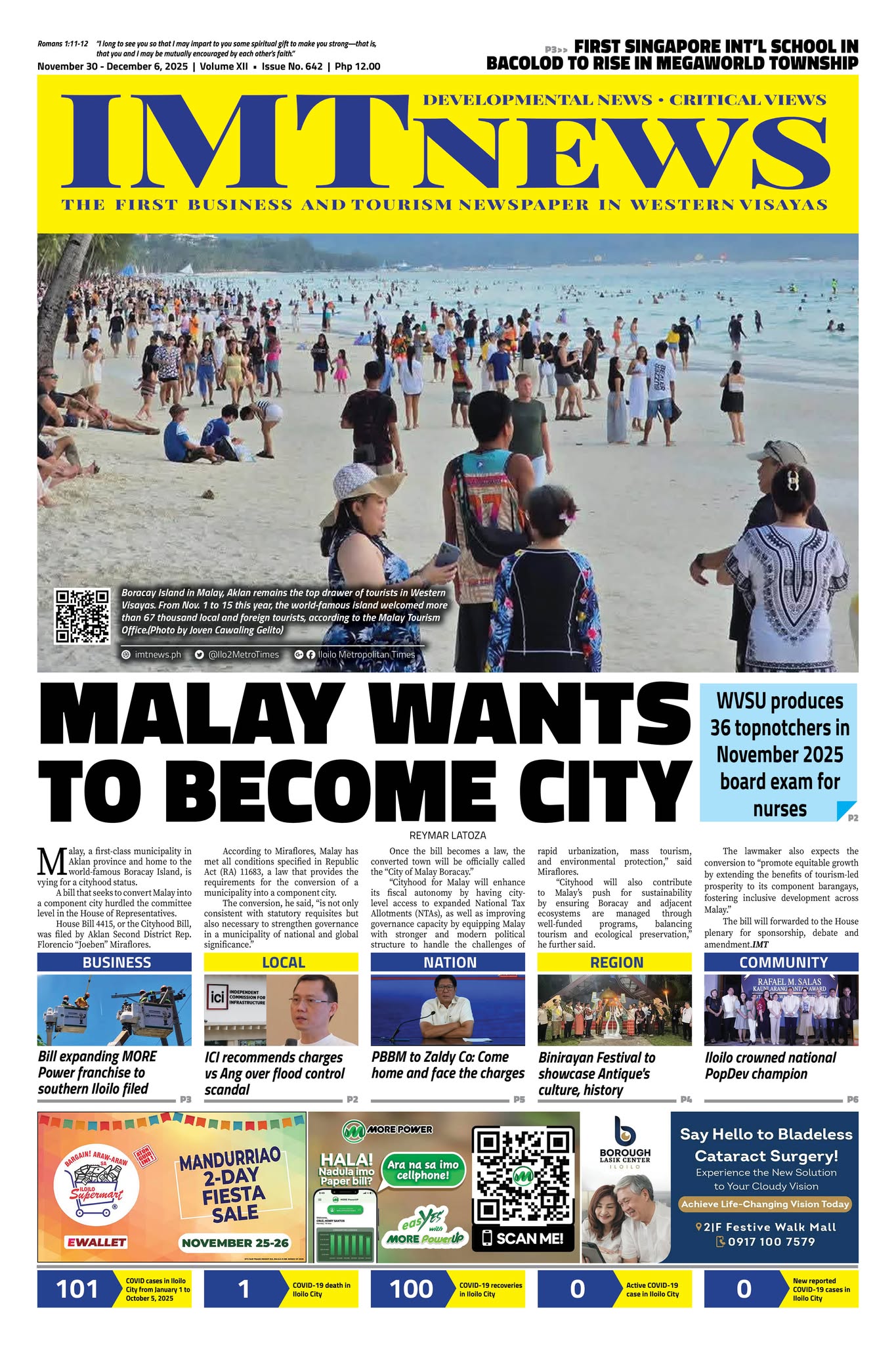The numbers did not whisper—they shouted. According to the 2024 FLEMMS survey, only 68.4% of people in Iloilo Province and 70.7% in Iloilo City are functionally literate—the lowest in Western Visayas. Once hailed as an academic stronghold, Iloilo now trails behind Aklan, Antique, Guimaras, and Capiz. And while “Functional literacy” may sound technical, its absence is deeply felt—a vendor miscounting change, a tricycle driver fooled by a contract, a jobseeker lost in a form, a voter swayed by empty slogans, a parent puzzled by a school memo, someone sharing fake news without knowing better, a worker unable to speak up clearly, a mother misreading a food label, a teen falling for online scams, a father confused by a child’s homework, a student struggling with a scholarship form, a kid mouthing lessons without meaning, or a small business owner signing a loan he barely understands. When people struggle to read between the lines—or even the lines themselves—they become easier to fool, easier to hurt, and harder to hear.
To read and write is not enough. As UNESCO reminds us, functional literacy means using basic education to navigate daily life—comprehending, applying, communicating. Institute of Contemporary Economics (ICE) Executive Director Bonnie Ladrido put it bluntly in his recent post: “Houston, we have a problem.” Referring to the alarmingly low functional literacy rates in Iloilo, he pointed out that this is more than just an education crisis—it is a serious barrier to both economic progress and human development.
What stings more is Iloilo’s reputation as an academic hub. From Philippine Science High School–Western Visayas to Ateneo de Iloilo, ISA, INHS SpecSci, Assumption, UP Visayas, CPU, WVSU, JBLFU, USA, and ISATU, among many others, the province houses some of the country’s top institutions. Yet all the prestige and diplomas in the city cannot hide the painful truth in many barangays and towns, where too many children still struggle to read a simple sentence by age ten.
Ladrido emphasizes that functional literacy is essential for turning education into real opportunity. Without the ability to apply reading, writing, and numeracy in everyday life, a diploma alone cannot guarantee employment, productivity, or sound decision-making. This, he warns, risks becoming a structural weakness that could hold back not just individuals, but the region’s economic competitiveness.
Why are other provinces doing better? In Aklan, the “secret” is not really a secret—LGUs are hands-on, not just with funds but with follow-through. They set reading targets, monitor scores, and treat literacy not as a DepEd problem but as a shared mission. In contrast, Iloilo’s response leans heavily on construction: classrooms, fences, occasional giveaways. These are necessary, but not sufficient. Cement can build schools, but not comprehension.
Inside many classrooms, teachers—many of them deeply committed and competent—juggle students at vastly different reading levels with little to no remedial support. Tutorials? Scarce. Reading specialists? Sporadic. EdTech aids? Scattered. The system expects miracles from educators armed only with chalk, photocopied modules, and hope. Worse, the culture of mass promotion—quietly acknowledged by educators and laid bare in EDCOM 2’s Miseducation report—lets students move up the ladder without mastering the basics. It protects the numbers, not the learning.
But the cost is not just in grades—it is in confidence. Struggling readers are often teased, labeled “lazy” or “slow,” and slowly shrink into silence or act out just to cope. Anxiety festers. Mental wellness suffers. Some drop out not because they lack potential, but because school becomes a place of shame instead of growth. Literacy struggles, when left unaddressed, do not just hurt report cards—they break spirits.
Add to that the cruel irony of updated curricula without updated materials. Modules arrive late, if at all. Teachers are assigned subjects far from their expertise—music majors teaching calculus, PE instructors handling physics. EDCOM 2 found that 62 percent of high school teachers are misassigned. No amount of passion can make up for such mismatches.
And then there’s the infrastructure gap: schools without power, connectivity, utilities, books, modules, labs, boards, or even chairs. These are not distant upland tales—they are happening in the heart of Western Visayas. While condominiums rise in a year, some classrooms take a decade to fix. Teachers use umbrellas to shield books from leaks; students sit on cardboard on flooded floors. How do we expect minds to grow in places the system forgets?
Ladrido stresses that functional literacy goes beyond test scores—it is about practical skills that impact safety, livelihood, and human dignity. When people cannot read a contract, interpret a medicine label, or fill out a job application, the consequences are immediate and deeply personal.
These are not abstract gaps; they are lived consequences.
Even gendered patterns in literacy raise flags. PSA data shows that 74.8 percent of women in Western Visayas are functionally literate, compared to just 66.6 percent of men. This begs deeper inquiry: Are boys leaving school earlier? Are interventions less engaging for them? Are cultural expectations skewing priorities? Without clear diagnosis, we risk applying the wrong cure.
Still, there are glimmers of hope. Bulig Eskwela sang Probinsya shows that targeted reading workbooks, guided interventions, and community-based tutorials can move the needle. But reaching only ten towns out of 42 is hardly enough. These programs must evolve from pilot projects into institutional norms—barangay reading maps, regular remediation classes, reading benchmarks integrated into school systems.
To be fair, the Department of Education is not asleep at the wheel. It has quietly rolled out efforts like the Comprehensive Rapid Literacy Assessment (CRLA), an enhanced Philippine Informal Reading Inventory (Phil-IRI), and revitalized Brigada Pagbasa partnerships. These aim to sharpen diagnostic tools and reboot reading support. And despite the challenge of scale, many Iloilo schools are now tapping LGU support more actively, signaling a shift from rhetoric to results.
But let us be clear: no slogan or tarpaulin campaign will fix this. As Ladrido emphasized, functional illiteracy is not just a school issue—it is a governance issue. If Iloilo wants to stay competitive, it must treat reading not as a side project but as a front-line investment. That means books before bunting, training over tokenism, and outcomes over checklists.
This moment is not a death sentence—it is a crossroad. Iloilo can accept its ranking and retreat, or it can use it as a wake-up call. To realign education goals with community needs. To unlearn harmful habits. To be allergic to mediocrity. To relearn how literacy builds not just brighter learners, but better futures.
For teachers and school heads, this is not about compliance. It is a quiet crusade. Every day, in crowded classrooms and underfunded faculty rooms, many continue to fight for each child’s right to understand the world through words. That grit deserves more than applause—it demands action. Because a province that reads is not just informed. It is empowered. And when a province reads together, it rises together.
Doc H fondly describes himself as a ”student of and for life” who, like many others, aspires to a life-giving and why-driven world grounded in social justice and the pursuit of happiness. His views do not necessarily reflect those of the institutions he is employed or connected with.






